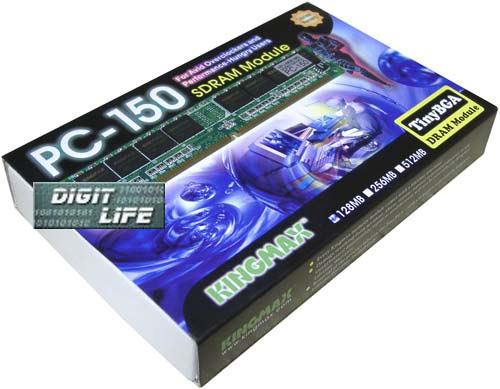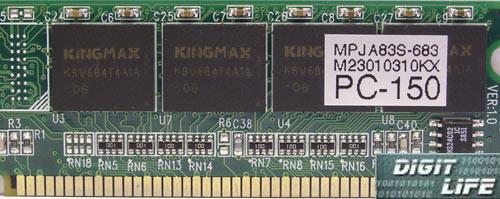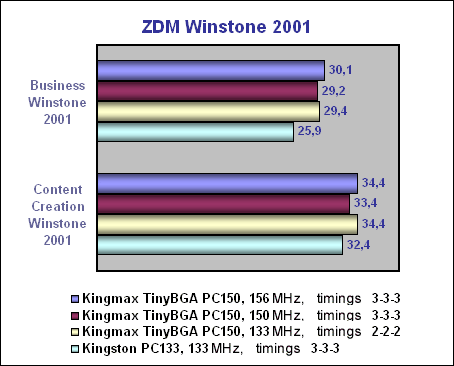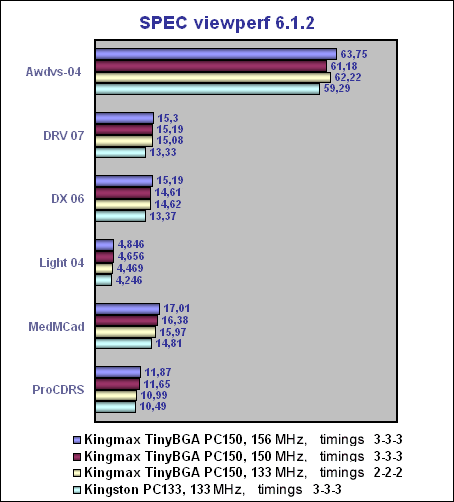I'm sure that many of us are anxious about how to choose a high quality
memory module. Everybody is tired of the lottery of Mtec, NpNx and other
similar companies when you never know whether you are buying a good or
an out-of-order module. Taking into account a quite favorable present-day situation
with prices of memory components, such modules will hardly
interest many. The market today gives quite a wide choice among brand-name
memory modules of excellent quality and of just good quality. The price
plays a vital role here: not always these modules can be purchased at an
acceptable sum of money. Besides, two other factors - efficiency and
reliability are often alternative. But anyway, one can find solutions possessing
harmonious combination of price, efficiency and reliability. One of such
modules is Kingmax TinyBGA PC150.
Key features

In 1997 Kingmax already offered a TinyBGA case for packing DRAM dies, which
was much similar to a µBGA and shared nearly all advantages of the latter over a
standard TSOP. In 1998 Kingpak, a daughter company, registered a corresponding
trade mark, and the mass production of SDRAM chips in TinyBGA cases started
up. Today most SDR SDRAM chips produced by Kingmax are packed
exactly in TinyBGA cases. And the KSV684T4A1A-06 chips mounted on our
TinyBGA PC150 module are not an exclusion. Let's find out what advantages this type of case
has as compared with other types.
Electrical parameters. First, TinyBGA cases allow reducing the
length of signal ways (by 25-30 %, according to Kingmax engineers).
It gives a possibility to reduce capacity, inductance and active resistance
of the track "die - in-cut connection" which improves noise-immunity and
frequency characteristics of the track. Another advantage over the TSOP
case lies in the fact that TinyBGA pins have lower mutual capacitance and
inductance. An amplitude of spurious signals induced in the neighbor flow
lines is, therefore, getting smaller which, again, causes a better noise-immunity
of the track.
It should be noted here that for reliable operation of memory modules
it is vital to have a motherboard of high quality. Many factors depend
on how good is the layout of the board and the shielding of signal lines of the
track "chipset - in-cut connection", and whether electrical parameters
of this track correspond to the specification requirements. Even the quality
of the in-cut connection may cause problems if its transient resistance
is too high. That is why one would hardly get good efficiency and an excellent
speed of even the best memory module if it is installed in a fishy motherboard.
Compactness. The TinyBGA case is rather compact - 12X9X1.4 mm
for 44-BALL TinyBGA and 13X11X1.4 mm for 54-BALL TinyBGA. Of course, the
module itself is also small - 133.35X25.4X3.94 mm.
Temperature mode. According to Kingmax specialists, the TinyBGA
case has a lower thermistor than the TSOP case. The die lies on a multilayer
mount which has a good thermal contact with a printed circuit board. As
a result, reduction of the Thetajb thermistor (junction-to-board)
causes reduction of the overall thermistor - Thetaja (junction-to-ambient).
The facilitated temperature mode gives not only a higher reliability
but also better frequency characteristics.
All above-mentioned features relate to the TinyBGA case but not to
the SDRAM die. As you can see, the case parameters are rather attractive
(according to Kingmax engineers, TinyBGA can operate flawlessly even at
300 MHz). And how good the die is will be shown in the tests below.
Another interesting feature, I've forgotten to mention, is the support
of not only two standard data transfer modes with a packet length equal
to 2 and 4 bits (burst length = 2 and burst length = 4), but also
of two additional modes - 8-bit packet (burst length = 8) and full page.
The latter two modes are optional according to JEDEC standards on SDR SDRAM,
and are not typical comparing to the majority of chips of other manufacturers. On
the one hand, such support deserves praise, but on the other hand, these
two modes are supported by far not all standard chipsets for PCs.
Examination
Kingmax TinyBGA PC150 module is delivered in a neat and cute retail-package.
I think you would agree that a colorful retail-box makes much better impression
than a polyethylene packet or a piece of foam-rubber tightened with elastic
;-)

As for the size, Kingmax's module is nearly 1.5 times lower than
a standard PC133 module from Kingston.

The MPJA83S-683 module, we managed to put our hands on, is one-sided: there
are only 8 chips on the printed circuit board, since only 128 Mbit SDRAM
chips with 16MX8 organization (4M X 8 X 4 logic banks) are used. The printed
circuit board and mounting of components give no cause for complaining.
There is of course a flash memory chip 2 Kbit in size (2K EEPROM in an
8-pin SOP case) that realizes SPD mechanism (Serial Presence Detect). Besides,
there are capacitive and resistance decouplings in feed and synchrosignal
circuits for each chip.

Testing
The test system configuration:
- ASUS CUSL2-CB (Black Pearl) motherboard
- Intel Pentium III 667 and Pentium III 733 processors
- NVIDIA GeForce2 Pro 64 MBytes (Core:200 MHz; Mem:200(400)MHz DDR) video card
- HDD IBM Deskstar 75GXP 45 GBytes 7200 rpm Ultra ATA/100
- DVD-ROM Panasonic 8x speed drive
- OS Windows 2000 Professional Service Pack 1
Software:
- StreamD
- Ziff-Davis Media Business Winstone 2000 v1.0.1
- Ziff-Davis Media Content Creation Winstone 2000 v1.0.1
- SPECviewperf v6.1.2 (resolution 1280x1024x32x100 Hz, OpenGL performance)
- idSoftware Quake III Arena v1.17 (OpenGL performance)
- MadOnion 3D Mark2001 (DirectX v8.0 performance) (resolution 1024x768x32x100Hz)
Test results





Comment. The maximum clock speed of the
bus ensuring a flawless system functioning is 156 MHz. At the
frequencies up to 160 MHz errors were noticed in applications.
Conclusion
It is rather a good and well implemented module!
Kingmax TinyBGA PC150 showed an exclusive efficiency at the
standard frequency of 133 MHz with the most advanced timings: the
performance increases greatly as compared with a standard 3-3-3
scheme. The module worked normally even at the frequency higher
than 150 MHz (though, only with conservative timings). In view of
the acceptable price, excellent performance and guaranteed reliability
Kingmax's TinyBGA PC150 memory module can be recommended not only
for overclockers but also for all PC users who are interested in
a well-functioning memory subsystem.
Besides, it should be noted that all Kingmax TinyBGA
memory modules have a life-long warranty, well, that really must mean something !
Write a comment below. No registration needed!









